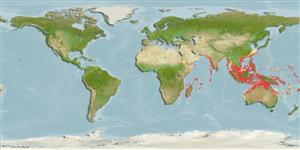Teleostei (teleosts) >
Eupercaria/misc (Various families in series Eupercaria) >
Caesionidae (Fusiliers) > Caesioninae
Etymology: Pterocaesio: Greek, pteron = wing, fin + Latin, caesius = blue grey (Ref. 45335).
More on author: Bleeker.
Environment: milieu / climate zone / depth range / distribution range
Ecology
Marine; reef-associated; non-migratory; depth range 1 - 100 m (Ref. 37816). Tropical; 30°N - 32°S, 32°E - 178°W (Ref. 402)
Indo-West Pacific: East Africa (excluding the Red Sea and Arabian (Persian) Gulf) eastward to Fiji. Reported from the Ryukyu Islands (Ref. 559).
Size / Weight / Age
Maturity: Lm ? range ? - ? cm
Max length : 21.0 cm TL male/unsexed; (Ref. 402); common length : 13.8 cm SL male/unsexed; (Ref. 37816)
Dorsal spines (total): 10 - 11; Dorsal soft rays (total): 14 - 16; Anal spines: 3; Anal soft rays: 11 - 13. Variable body coloration, dark red to silvery, paler ventrally with lateral line darker; often yellowish snout and eyes. Caudal fin tips distinctly black or reddish black (Ref. 48636). 4-5 scales on cheek; 21-29 predorsal scales; scaled dorsal and anal fins. Upper peduncular scale rows usually 11 (10-12); lower peduncular scale rows usually 15 (13-17). ventrolateral surface of basioccipital with a broad process for attachment of Baudelot's ligament. Post maxillary with 2 processes; posterior end of maxilla tapered (Ref. 1723). Head length 3.0-3.5 in SL; body depth 3.6-4.8 in SL (Ref. 90102).
Ranges widely around coral reefs (Ref. 58652), sometimes forming schools with other Pterocaesio species. Feeds on zooplankton in midwater aggregations. Oviparous, with numerous, small pelagic eggs (Ref. 402). Also caught mostly by drive-in nets. Important tuna baitfish.
Life cycle and mating behavior
Maturity | Reproduction | Spawning | Eggs | Fecundity | Larvae
Carpenter, K.E., 1987. Revision of the Indo-Pacific fish family Caesionidae (Lutjanoidea), with descriptions of five new species. Indo-Pac. Fish. (15):56 p. (Ref. 1723)
IUCN Red List Status (Ref. 130435: Version 2024-2)
Threat to humans
Harmless
Human uses
Fisheries: commercial; bait: usually
Tools
Special reports
Download XML
Internet sources
Estimates based on models
Preferred temperature (Ref.
123201): 25.9 - 28.4, mean 27.5 °C (based on 310 cells).
Phylogenetic diversity index (Ref.
82804): PD
50 = 0.5002 [Uniqueness, from 0.5 = low to 2.0 = high].
Bayesian length-weight: a=0.01000 (0.00549 - 0.01823), b=3.10 (2.94 - 3.26), in cm total length, based on LWR estimates for this species & Genus-body shape (Ref.
93245).
Trophic level (Ref.
69278): 3.4 ±0.45 se; based on food items.
Generation time: 1.0 ( na - na) years. Estimated as median ln(3)/K based on 1
growth studies.
Resilience (Ref.
120179): High, minimum population doubling time less than 15 months (K=1.05).
Fishing Vulnerability (Ref.
59153): Low vulnerability (14 of 100).
Nutrients (Ref.
124155): Calcium = 86.4 [57.2, 142.7] mg/100g; Iron = 0.958 [0.616, 1.459] mg/100g; Protein = 18.9 [17.9, 19.9] %; Omega3 = 0.165 [0.107, 0.249] g/100g; Selenium = 39.5 [23.6, 70.6] μg/100g; VitaminA = 94.5 [38.9, 238.3] μg/100g; Zinc = 1.37 [0.97, 1.86] mg/100g (wet weight);
